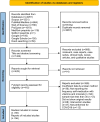Prevalence of self-medication with vitamin or mineral supplements in the prevention and treatment of COVID-19: a systematic review and meta-analysis
- PMID: 40394722
- PMCID: PMC12090409
- DOI: 10.1186/s40795-025-01083-5
Prevalence of self-medication with vitamin or mineral supplements in the prevention and treatment of COVID-19: a systematic review and meta-analysis
Abstract
Background: Self-medication, as a self-care practice, increased dramatically during the COVID-19 pandemic. Among the most prevalent medications used for self-medication were vitamins and minerals. Accordingly, this study aimed to estimate the prevalence of self-medication with vitamins or minerals for preventing and treating COVID-19 and its related factors.
Material and method: A comprehensive search was performed in four electronic databases (PubMed, Web of Science, Scopus, and ProQuest), two preprint repositories (MedRxiv and SciELO), two grey literature sources (Google and Google Scholar), and the reference lists of eligible studies in January 2024. The search strategy was built on two core concepts: "self-medication" and "COVID-19". No language, place, and time restrictions were applied. Risk of bias assessment tool was adapted from Hoy checklist. The protocol of this study was registered under the code CRD42023434567 in the open-access online database of the International Prospective Register of Systematic Reviews (PROSPERO). A random effect model was applied to estimate the pooled prevalence of self-medication. Statistical heterogeneity among the studies was assessed using both the I2 statistic and the χ2 test. Moreover, subgroup analysis and meta-regression model were used to identify the potential sources of methodological heterogeneity of the studies. A two‑sided P-value < 0.05 was considered statistically significant.
Results: Out of 1424 non-duplicate studies, 56 were included in the meta-analysis. Vitamin C, vitamin D, B complex, multivitamins, and zinc were most commonly used for self-medication. The pooled prevalence of self-medication with vitamins was 29% (95% CI: 22%,37%; I2 = 99.62%), with minerals 15% (95% CI: 8%, 23%; I2 = 99.68%), and the corresponding value for the concomitant use of minerals and vitamins was 34% (95% CI: 27%, 42%; I2 = 98.72%). The subgroup analysis showed people who lived in the American continent practiced self-medication with vitamins less (Pooled prevalence: 12%, 95% CI: 8%,16%; I2 = 91.39%), and self-medication with vitamins and minerals was most prevalent in Asia. Besides; according to I2 values, the continents in which the studies were conducted could be the reason for the statistical heterogeneity.
Conclusion: The reported prevalence of self-medication with vitamins and minerals to prevent and treat COVID-19, especially in Asia, is concerning and needs more public health action. In addition, people should be educated about the possibility of poisoning with vitamins and minerals because awareness of the risks of supplements can reduce self-medication practices at present and even in future pandemics.
Keywords: COVID-19; Meta-analysis; Pandemic; Prevalence; Self-medication; Systematic review.
© 2025. The Author(s).
Conflict of interest statement
Declarations. Ethics approval and consent to participate: This study was approved by the Ethics Committee of Hormozan University of Medical Sciences, Bandar Abbas, Iran (code: IR.HUMS.REC.1400.278). Consent to participate: Not applicable. Consent for publication: Not applicable. Competing interests: The authors declare no competing interests.
Figures




Similar articles
-
Prevalence and Correlates of Self-Medication Practices for Prevention and Treatment of COVID-19: A Systematic Review.Antibiotics (Basel). 2022 Jun 16;11(6):808. doi: 10.3390/antibiotics11060808. Antibiotics (Basel). 2022. PMID: 35740214 Free PMC article. Review.
-
Prevalence of self-medication during COVID-19 pandemic: A systematic review and meta-analysis.Front Public Health. 2022 Nov 3;10:1041695. doi: 10.3389/fpubh.2022.1041695. eCollection 2022. Front Public Health. 2022. PMID: 36408026 Free PMC article.
-
Prevalence of self-medication among the elderly: A systematic review and meta-analysis.J Educ Health Promot. 2023 Feb 28;12:67. doi: 10.4103/jehp.jehp_630_22. eCollection 2023. J Educ Health Promot. 2023. PMID: 37113410 Free PMC article. Review.
-
Mental health problems in pregnant and postpartum women living with HIV in sub-Saharan Africa: Systematic review and meta-analysis protocol.PLoS One. 2024 Oct 3;19(10):e0308810. doi: 10.1371/journal.pone.0308810. eCollection 2024. PLoS One. 2024. PMID: 39361676 Free PMC article.
-
Food fortification with multiple micronutrients: impact on health outcomes in general population.Cochrane Database Syst Rev. 2019 Dec 18;12(12):CD011400. doi: 10.1002/14651858.CD011400.pub2. Cochrane Database Syst Rev. 2019. PMID: 31849042 Free PMC article.
References
-
- Organization WH. Guidelines for the regulatory assessment of medicinal products for use in self-medication. In. World Health Organization; 2000.
LinkOut - more resources
Full Text Sources
